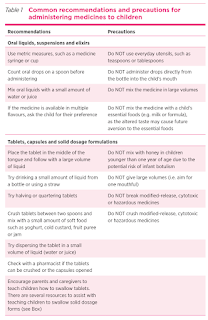Administration of Medicines to Children
Introduction
Giving medicines to infants and children can be challenging because they may refuse to take medications for many reasons, such as fear, taste, embarrassment or inconvenience.
Choosing the Right Formulation
When selecting medicines for children, it is important to consider factors such as
- Child's age
- Swallowing ability
- Ease of administration
- Accessibility of suitable formulations of the product
Often, oral liquids are the preferred formulation for younger children as they are easier to swallow and allow for flexible dosing based on the child's age and weight.
- Multiple formulations of the same active ingredient are available and may contribute to dosing errors, such as paracetamol 120 mg/ml and 250 mg/ml suspension.
Also, when choosing an oral liquid medicine, the following must be considered:
- Excipient content, including quantity and suitability
- Cumulative daily excipient intake from all products being taken
- Potential adverse effects due to excipients
- The risk-benefit analysis of using an unlicensed product vs a licensed product
- The cocentration of the product and the dose volume
- Ideally the dosing volume should not be less than 0.2 ml or more than 10 ml, though it may be necessary to administer smaller volumes within neonatal critical care.
- Where smaller volumes are required, consideration should be given to how these can be safely administered to minimise the potential for error.
- Any local agreement on use of standard concentrations, in both primary and secondary care
Common Recommendations and Precautions
- If the child does not consume the entire bottle or all the food, then an unknown proportion of the dose may have been taken.
Medication Compliance
Few key factors affecting paediatric patient on medication compliance include:
- Medication itself, e.g. Taste?
- Dosage regimen, e.g. Dosing around school time? Dosing frequency?
- Illness being treated
- Patient and caretaker - Sense of urgency?
The KIDs List
Similar to Beers Criteria for older adults, the Key Potentially Inappropriate Drugs in Pediatrics (KIDs) List is an evidence-based resource designed to improve medication safety in children.
- The KIDs list identifies 67 medications or medication classes and 10 excipients that may pose potential risks and adverse effects in the pediatric population.
- If avoidance is not clinically possible, the drugs should be used with caution and accompanied by appropriate monitoring.
- Also, this list was developed within an US context, focusing on FDA-approved medications available in the United States.
External Links
- Medicines Learning Portal - Children
- Medicines for Children - How to give different types of medicines
- Medicines for Children - Excipients in children’s medicines
- Paediatric pharmacokinetics and drug doses, 2016
- NPPG Choosing An Oral Liquid Medicine for Children, 2020
- Key Potentially Inappropriate Drugs in Pediatrics: The KIDs List, 2020
- Key Potentially Inappropriate Drugs in Pediatrics: The KIDs List, 2021
- Administration of medicines to children: a practical guide, 2022







Comments
Post a Comment